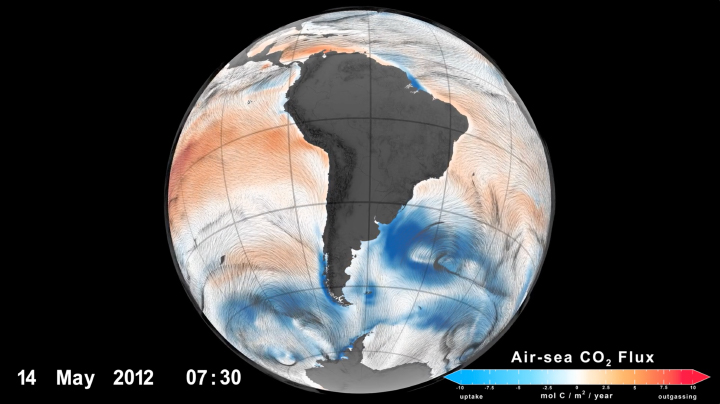

New observations from research aircraft indicate that the Southern Ocean absorbs more carbon from the atmosphere than it releases, confirming that it is a strong carbon sink and an important buffer for the effects of human-caused greenhouse gas emissions. Previous research and modeling had left researchers uncertain about how much atmospheric carbon dioxide (CO2) gets absorbed by the chilly waters circling the Antarctic continent.
In a NASA-supported study published in Science in December 2021, scientists used aircraft observations of atmospheric carbon dioxide to “show that the annual net flux of carbon into the ocean south of 45°S is large, with stronger summertime uptake and less wintertime outgassing than other recent observations have indicated.” They found that the waters in the region absorbed roughly 0.53 more petagrams (530 million metric tons) of carbon than they released each year.
“Airborne measurements show a drawdown of carbon dioxide in the lower atmosphere over the Southern Ocean surface in summer, indicating carbon uptake by the ocean,” explained Matthew Long, lead author of the study and a scientist at the National Center for Atmospheric Research (NCAR). Aircraft observations were collected from 2009 to 2018 during three field experiments, including NASA’s Atmospheric Tomography Mission (ATom) in 2016.
The animation and still image on this page show areas where carbon dioxide was absorbed (blue) and emitted (red) by the global ocean in 2012. (Jump to 1:00 to focus on the Southern Hemisphere.) The data come from the ECCO-Darwin Global Ocean Biogeochemistry Model. The research was funded by the National Science Foundation, NASA, and the National Oceanic and Atmospheric Administration.

When human-caused emissions of carbon dioxide enter the atmosphere, some of the gas is absorbed by the ocean, a process that can slightly slow carbon accumulation in the atmosphere and the global temperature increases that go with it. Part of this is due to upwelling of cold water from the deep ocean. Once at the surface, colder, nutrient-rich water absorbs CO2 from the atmosphere—usually with the help of photosynthesizing organisms called phytoplankton—before sinking again.
Computer models suggest that 40 percent of the human-produced CO2 in the ocean worldwide was originally absorbed from the atmosphere into the Southern Ocean, making it one of the most important carbon sinks on our planet. But measuring the flux, or exchange, of CO2 from the air to the sea has been challenging.
Many previous studies of Southern Ocean carbon flux relied heavily on measurements of ocean acidity—which increases when seawater absorbs CO2—taken by floating, drifting instruments. The new research used aircraft to measure changes in the concentration of CO2 in the atmosphere over the ocean.
“You can’t fool the atmosphere,” Long said. “While measurements taken from the ocean surface and from land are important, they are too sparse to provide a reliable picture of air-sea carbon flux. The atmosphere, however, can integrate fluxes over large expanses.”
For the new study, researchers used airborne measurements from three field experiments: ATom, HIPPO, and ORCAS. Collectively, the field experiments captured a series of snapshots (or profiles) of the vertical change in carbon dioxide across various altitudes of the atmosphere and various seasons. For example, during the ORCAS campaign in early 2016, scientists saw a drop in CO2 concentrations as the plane descended and also detected high turbulence near the ocean surface, suggesting an exchange of gases. Such profiles, along with several atmospheric models, helped the team better estimate the flux of carbon.
Video by NASA's Scientific Visualization Studio and data from the ECCO-Darwin Global Ocean Biogeochemistry Model. Story by Sofie Bates, NASA’s Earth Science News Team.
The waters circling Antarctica absorb more carbon from the atmosphere than they release, serving as a strong carbon sink and an important buffer for greenhouse gas emissions.
Image of the Day for January 2, 2022